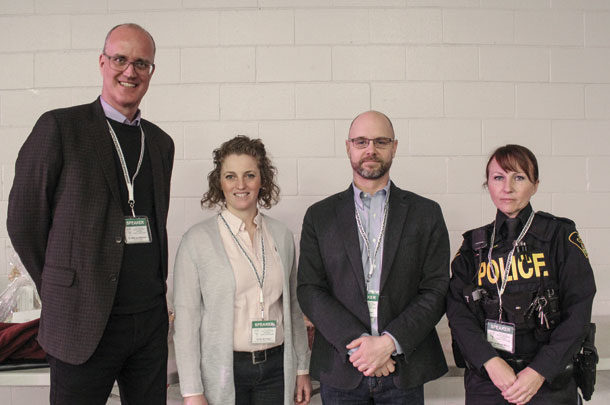At the 2020 Southwestern Ontario Dairy Symposium, three panelists discussed this scenario during their presentation, “Planning for non-authorized visitors on the farm.”
Moderated by Mike von Massow, associate professor at the University of Guelph, the panelists were: Emily den Haan, dairy producer, Haanview Holsteins and Sheldon Creek Dairy in Alliston, Ontario; Kurtis Andrews, farm and animal welfare lawyer, Kurtis R. Andrews, Barrister & Solicitor in Ottawa, Ontario; and Sergeant Laura Lee Brown, regional community services coordinator, Ontario Provincial Police West Region headquarters.
A dairy producer’s perspective
Den Haan, along with her parents, sister and brother-in-law, farms 500 acres of land, operates a 1-year-old, 60-cow robotic milking facility and runs an on-farm processing facility. Sheldon Creek Dairy was built in 2012 as an initiative to educate the public. In their previous tiestall facility, the family would host public open houses (welcoming more than 5,000 people to the farm). They designed the new barn with tours and open houses in mind.
However, “being in the public eye and with the proximity to Toronto, our farm is on contact alert for protestors and activists,” den Haan explained.
To date, the farm has had one high-alert notification. “We were alerted a few weeks in advance that there was going to be an animal rights protest. We immediately reached out to Farm and Food Care. They supported us and helped us to strategize and plan for the day,” she said.
The plan included two steps:
1. Call the police. Den Haan said, “These people are our threat. They are a threat to yourself, to your farm safety, to your livestock’s safety; and I think we’re learning more about that in our industry. It’s really important to take that seriously and realize that these are not just trespassers anymore; they are a serious threat.”
2. Remain calm. “Remember that the police are on their way, and that you are doing nothing wrong. We were advised to continue to ask them to please leave, tell them that they’re trespassing and remind them that you will be charging them. Don’t be afraid to take photos,” she said. Photos of licences and faces will help if pressing charges after the incident.
A week before the alerted protest, the threat escalated, and the police took it into their own hands. They sat down with the den Haans and heard their plan, looked at what information was available and then decided it was an “official protest,” so they would be there to keep the peace. The family also signed a document allowing the police to act on their behalf if anyone did trespass.
“It was important for us to remember that keeping the peace doesn’t mean that they’re going to tell these people to go home right away. They have the right to peacefully protest on the road, and we have to remember that,” den Haan said.
Although the protestors did not end up at their farm, they did show up at a neighbour’s farm, and the den Haans were able to help by notifying the police.
“Our key takeaway from that was: It was really good to just sit down and have a conversation with your local police force. If you think that this might happen to you – it could happen on any farm in Canada – it’s really a good idea to just build a relationship or make that connection with your police force that they know who you are, they know what’s going on in the industry and that this is something to be taken seriously,” she said.
Learning from this experience, the den Haans installed video cameras at all entrances of the barn and put locks on the doors.
“Know your rights, talk to your local police officer, and make a plan. Make sure that it’s known between you and your employees, so that if somebody shows up on your farm unexpectedly, you know exactly what you’re going to do,” den Haan said. “I think the only thing that we can really do, to stop the protesting, is to reconnect with the consumer. We need to not only tell our story, but we need to regain trust and build a relationship with the consumer – and we need to do that through marketing.”
A lawyer’s perspective
Andrews grew up on a farm near Milton, Ontario. His legal practice focuses on agricultural issues, including family disputes, defence and regulatory matters affecting farmers, and animal welfare and activism issues. From his perspective, he stated, “Activists have been breaking the law for several years and are becoming bolder and bolder in doing so.”
He identified the three prevalent areas where activists target their activities and strategies:
- Farm invasions (Andrews added the intent of the new Bill 156, Security from Trespass and Protecting Food Safety Act, 2020, in Ontario is directed at addressing this type of behaviour.)
- Undercover operations
- Harassment of transport vehicles
From a lawyer’s point of view, you can address these unwanted activities in a few different ways. He said, “If the activists are breaking the law, you can call the police and get them involved, and hopefully there will be an investigation. If it’s found through the investigation that laws have been broken, there will be charges, and the legal system will do its work. There are also civil options.
You can potentially sue these individuals as well. We have a Trespass to Property Act, so you’re breaking a provincial law by trespassing. We also have the tort of ‘Trespass to land’, so you can sue for trespassing as well.” He said the benefit of civil proceedings is: You have control over it, but it is more expensive.
“I want to re-emphasize for you, when the activists come on to your property, you need to call 911. When somebody comes on your property, in particular if there is a group of them and you don’t know who they are – that’s a genuine threat. You don’t know who they are; you don’t know what their intentions are; you don’t know what’s going to happen next,” Andrews said.
He also suggested you maintain good record-keeping by keeping a logbook to record animal welfare incidents that occur on the farm and have employees sign animal welfare agreements in order to have a good record of how things were before the incident versus how things were after the incident.
A police officer’s perspective
Brown manages the community safety educational outreach program for 14 counties in the western region of Ontario. She expressed, “The interaction between police and the public, regardless of the opinion, the expression or the assembly, is something that has really evolved over time for us as police. We’ve made changes within our own organization to ensure that our involvement in these incidents focuses on what needs to happen, which is preserving the peace and keeping open lines of communication. Our role is quite simple: to remain impartial and ensure that everybody stays safe.”
Brown explained how programs such as the OPP provincial liaison team (PLT) works “to build relationships with individuals and groups on both sides in efforts to create safe environments for differing viewpoints to be expressed.” She emphasized how having these relationships ahead of time is very useful to the police. “Additional support is through our community safety services teams. Many of them, including myself, regularly meet with producers in small or large groups to discuss safety strategies, crime prevention, response plans and the types of services that we have available,” she said.
The coming change to legislation (Bill 156) was created specifically to address the unique needs and concerns that trespassing poses to the farming community. “Our involvement, however, of those occurrences still needs to be carefully and individually weighed – it would make no sense, and it is not prudent, to look at every situation the same,” she stated.
Brown also added, “Just because someone isn’t necessarily arrested at that moment or charged, doesn’t mean that they won’t be at a later point in time. That’s really important for people to recognize, and the changing legislation will also provide a greater opportunity to that over a longer period of time. Once we bring that matter before the courts, we have no further role to play in the decision-making process, so our involvement ends after that.”
A person is breaking the law as soon as they trespass onto your private property, according to both Brown and Andrews. Signs are helpful but not necessary for it to be considered “trespassing” according to the Trespass to Property Act.
Stressing how important it is to have a plan in place, Brown reiterated, “If you’re feeling threatened, 911 is the number to use; regardless of where you are, who you are or what time of day, please call 911 and convey that it is a threat. It’s equally important to recognize and remember that unknown individuals pose equally unknown risks.” A few take-away points from Brown included:
- When you call 911, the communications specialists are perceiving that as an emergency. They’ll start asking a series of questions, so make sure you give them as much information as possible, and they will come.
- Research the opportunities in your region for organizations to come to your farm to conduct a safety and property assessment (current and new builds).
- Lock and secure the property, not only for trespassing but for theft as well.
- The intent of the police is always going to be to try and resolve a situation as safely as possible.
Between the panelists, the message stays the same: Be prepared and protect yourself, your family, your livestock and your livelihood by having a plan in place. Call the police, stay calm, know your rights, and be ready for when non-authorized visitors visit you. ![]()
PHOTO: Southwestern Ontario Dairy Symposium 2020 were the panelists, left to right: Mike von Massow, associate professor, University of Guelph; Emily den Haan, Haanview Holsteins and Sheldon Creek Dairy; Kurtis Andrews, Kurtis R. Andrews, Barrister & Solicitor; and Sergeant Laura Lee Brown, Ontario Provincial Police. Photo by Lora Bender.
Visit Farm and Food Care for more information and templates. Learn more about the OPP’s provincial liaison team (Ontario only; otherwise, contact your local provincial police to research what tools are available for you).









